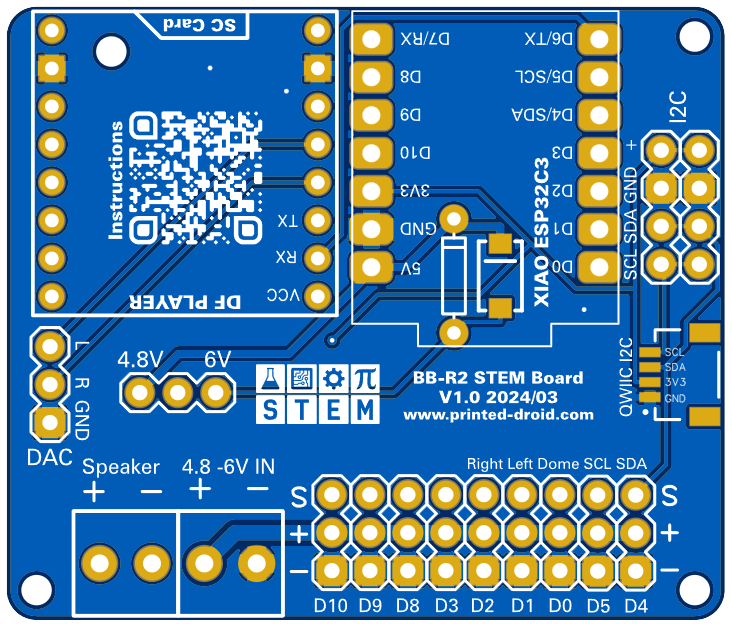The BB-R2 STEM Board is an open source board for Björn Gieslers BB-R2 STEM project.
The Project/Code can be found here: https://github.com/bjoerngiesler/BB-R2_STEM_ESP32
Gerber files are at the bottom of this page. (Please be aware this is the first revision, real life test pending!)
History of the project:
This project is the result of preparing for a live droid building session at the 2023 Stuttgart Comic Con, organized by the R2 Builders Club. The main objective is to guide up to 10 inexperienced builders or small builder teams for an hour or more, focusing on various aspects of droid building. This includes selecting appropriate hardware, materials, deciding between static and moving droids, choosing power supplies, remote controls, electronics, and more. The ultimate goal is to provide each participant with a practical small droid to take home, and Baby R2s are the ideal choice for this purpose. With permission from Michael Baddeley, I created a prototype and developed the necessary code for this project.
Design requirements and choices:
To be usable for a STEM session during a con, the project had to fulfill the following design goals:
- Let’s aim for excitement! Now, everyone’s definition of excitement may vary, but for me, it involves a droid that can move and make sounds.
- It should also be budget-friendly (less than 50€ for the current bill of materials)
- Suitable for beginners, and safe to use.
- Additionally, it should be designed for easy customization, allowing participants to continue enjoying their droid long after the event.
Based on these requirements, it became evident that using a regular RC controller/receiver combo was not suitable. Although these are readily available at low prices, they would still account for a considerable portion of the bill of materials (BOM) cost. Additionally, they lack the capability to generate sounds without the inclusion of extra circuitry. Instead, I decided to utilize a droid that…
- The device can be easily operated with either an Android or iOS smartphone through Bluetooth, which is commonly owned by most individuals. Our designated mobile application, Dabble, facilitates this functionality.
- It utilizes the ESP32 microcontroller, specifically the Seeed Xiao ESP32C3, as both a receiver and logic device.
- The device is powered by four AA batteries, preferably rechargeable, eliminating the need for a charger.
- Sound output is provided by a DFPlayer MP3 player module alongside small speakers.
- The drive and dome movement is controlled by continuous rotation servos, a feature adopted from the original project by Michael Baddeley.
- The electronic components are assembled on a small breadboard using pin wires, requiring three pins for the servos and two pins for controlling the MP3 player. (Which is now a PCB)

Board BOM:
- 1x Seees Studio XIAO ESP32C3
- 1x DFPlayer Mini (+SD card ~1GB)
- ~50 2.54mm pin headers (servos)
- 1x jumper 2.54mm
- 2x 8pin 2.54mm female pin header (DF Player)
- 2x 7pin 2.54mm female pin header (ESP32C3)
- 2x 3.5mm 2pin terminals (power and speaker)
- 1x Diode smd or tth (Silizium) – if you want to use 4x 1.5v batteries
(if you use rechargeable batteries with 1.2V it’s not needed) - 1x 4pin qwiik smd connector (alternativly use one of the 2 I2C pin headers)
